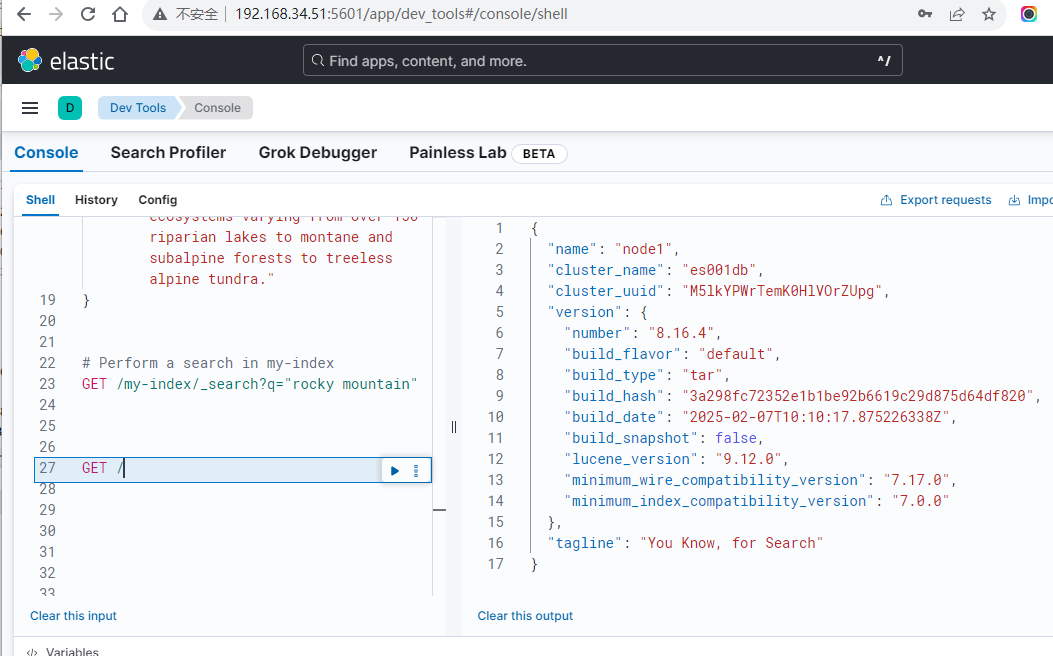Elasticsearch 麒麟V10下單機(jī)部署Elasticsearch8及Kibana
實踐環(huán)境
elasticsearch-8.16.4-linux-x86_64.tar.gz
https://artifacts.elastic.co/downloads/elasticsearch/elasticsearch-8.16.4-linux-x86_64.tar.gz
kibana-8.16.4-linux-x86_64.tar.gz
https://artifacts.elastic.co/downloads/kibana/kibana-8.16.4-linux-x86_64.tar.gz
麒麟V10
新建運行用戶
# groupadd -g 505 elastic
# useradd -u 505 -g 505 elastic
修改系統(tǒng)參數(shù)配置
# vi /etc/sysctl.conf
vm.overcommit_memory=1
vm.max_map_count=262144
# sysctl -p
# 查看語言配置
# locale
LANG=zh_CN.UTF-8
LC_CTYPE="zh_CN.UTF-8"
...
# swapoff -a
# vi /etc/security/limits.conf
# End of file
elastic soft memlock unlimited
elastic hard memlock unlimited
# ulimit -l unlimited
說明:如果locale命令輸出和上述不一樣,修改locale.conf配置,設(shè)置LANG=zh_CN.UTF-8
# vi /etc/locale.conf
...
LANG=zh_CN.UTF-8
bootstrap.memory_lock相關(guān)配置
禁用swap
# swapoff -a
永久配置
# vi /etc/fstab
去掉swap所在行
#
# /etc/fstab
# Created by anaconda on Wed Jul 5 22:21:55 2023
#
# Accessible filesystems, by reference, are maintained under '/dev/disk/'.
# See man pages fstab(5), findfs(8), mount(8) and/or blkid(8) for more info.
#
# After editing this file, run 'systemctl daemon-reload' to update systemd
# units generated from this file.
#
/dev/mapper/klas-root / xfs defaults 0 0
UUID=59b10633-de57-4a13-83c5-49ea947edefc /boot xfs defaults 0 0
/dev/mapper/klas-opt_data /opt/data xfs defaults 0 0
/dev/mapper/klas-opt_log /opt/log xfs defaults 0 0
#/dev/mapper/klas-swap swap swap defaults 0 0
# vi /etc/security/limits.conf
添加以下配置:
# End of file
elastic soft memlock unlimited
elastic hard memlock unlimited
# ulimit -l unlimited
注意:如果不執(zhí)行上述這行命令,啟動時會報錯:
bootstrap check failure [1] of [2]: memory locking requested for elasticsearch process but memory is not locked;
參考連接:
停止防火墻
# systemctl disable firewalld
# systemctl stop firewalld
elasticsearch
提前創(chuàng)建elasticsearch.yml、jvm.options配置相關(guān)目錄,否則運行ES時會報錯
# mkdir /opt/data/esdata
# mkdir -p /opt/data/eslogs/jvm/logs
# mkdir -p /opt/data/eslogs/jvm/tmpdir
# mkdir -p /opt/data/eslogs/jvm/data
解壓壓縮包
# cd /opt/data/
# tar -xvf elasticsearch-8.16.4-linux-x86_64.tar.gz
修改elasticsearch.yml
修改配置
# vi /opt/data/elasticsearch-8.16.4/config/elasticsearch.yml
關(guān)鍵配置項如下
# 集群名稱
cluster.name: es001db
# 節(jié)點名稱
node.name: node1
# 監(jiān)聽IP地址(本機(jī)地址)
network.host: 192.168.34.51
# 監(jiān)聽端口地址
http.port: 19200
# 增加內(nèi)部通訊端口
transport.port: 19300
# 節(jié)點發(fā)現(xiàn)過程中的種子,默認(rèn)為 ["127.0.0.1", "[::1]"]
# 這里因為是單機(jī),所以保持配置不變
#discovery.seed_hosts: ["host1", "host2"]
# 初始有master資格的節(jié)點列表,只在集群第一次啟動有效
cluster.initial_master_nodes: ["node1"]
#數(shù)據(jù)存儲目錄路徑
path.data: /opt/data/esdata
# 日志存儲目錄路徑
path.logs: /opt/data/eslogs
# 在數(shù)據(jù)庫層面金庸swap,同時設(shè)置會場參數(shù)memlock值為unlimited
bootstrap.memory_lock: true
修改jvm.options
修改配置
# vi /opt/data/elasticsearch-8.16.4/config/jvm.options
關(guān)鍵配置項如下
# 編碼設(shè)置
-Dfile.encoding=zh_CU.UTF-8
# JVM內(nèi)存配置
-Xms16g
-Xmx16g
## JVM 臨時目錄
-Djava.io.tmpdir=/opt/data/eslogs/jvm/tmpdir
# dump日志路徑
-XX:HeapDumpPath=/opt/data/eslogs/jvm/data
# fatal日志配路徑
# 注意:/opt/data/eslogs/jvm/logs目錄必須提前創(chuàng)建,如果不存在的話
-XX:ErrorFile=/opt/data/eslogs/jvm/logs/hs_err_pid%p.log
# gc 日志
-Xlog:gc*,gc+age=trace,safepoint:file=/opt/data/eslogs/jvm/logs/gc.log:utctime,level,pid,tags:filecount=32,filesize=64m
修改log4j2.properties(可選)
# vi /opt/data/elasticsearch-8.16.4/config/log4j2.properties
關(guān)鍵配置默認(rèn)如下,無須修改
logger.index_indexing_slowlog.level = trace
基礎(chǔ)安全設(shè)置
首次啟動Elasticsearch時,會為elastic用戶生成密碼,并自動配置TLS。如果在啟動Elasticsearch節(jié)點之前手動配置了安全性,則自動配置過程將遵循自定義安全配置。可以隨時調(diào)整TLS配置,例如更新節(jié)點證書。
如果集群有多個節(jié)點,那么必須在節(jié)點之間配置TLS。如果不啟用TLS,生產(chǎn)模式集群將無法啟動。
傳輸層依賴于雙向TLS來對節(jié)點進(jìn)行加密和身份驗證。正確應(yīng)用TLS可確保惡意節(jié)點無法加入集群并與其他節(jié)點交換數(shù)據(jù)。雖然在HTTP層實現(xiàn)用戶名和密碼身份驗證對于保護(hù)本地集群很有用,但節(jié)點之間的通信安全需要使用TLS。
在節(jié)點之間配置TLS是基本的安全設(shè)置,可防止未經(jīng)授權(quán)的節(jié)點訪問集群。
理解傳輸上下文
傳輸層安全(TLS)是一項行業(yè)標(biāo)準(zhǔn)協(xié)議的名稱,用于對網(wǎng)絡(luò)通信實施安全控制(如加密)。TLS是過去稱為安全套接字層(SSL)的現(xiàn)代名稱。Elasticsearch文檔中可互換使用TLS和SSL這兩個術(shù)語。
傳輸協(xié)議是Elasticsearch節(jié)點之間用于通信的協(xié)議名稱。此名稱特定于Elasticsearch,用于區(qū)分傳輸端口(默認(rèn)9300)和HTTP端口(默認(rèn)9200)。節(jié)點之間使用傳輸端口進(jìn)行通信,而REST客戶端則使用HTTP端口與Elasticsearch進(jìn)行通信。
盡管“transport”一詞在兩種情境下都有出現(xiàn),但它們的含義卻不同。可以將TLS應(yīng)用于Elasticsearch的傳輸端口和HTTP端口。這些重疊的術(shù)語可能會造成混淆,因此為了澄清,在此場景下我們將TLS應(yīng)用于Elasticsearch的傳輸端口。在下一場景中,我們將把TLS應(yīng)用于Elasticsearch的HTTP端口。
生成證書頒發(fā)機(jī)構(gòu)(certificate authority)
在集群中,可以根據(jù)需要添加任意數(shù)量的節(jié)點,但這些節(jié)點必須能夠相互通信。集群中節(jié)點之間的通信由傳輸模塊處理。為了保護(hù)集群,必須確保節(jié)點間的通信是加密且經(jīng)過驗證的,這可以通過雙向TLS來實現(xiàn)。
在安全的集群中,Elasticsearch節(jié)點在與其他節(jié)點通信時使用證書來標(biāo)識自己。
集群必須驗證這些證書的真實性。推薦的做法是信任特定的證書頒發(fā)機(jī)構(gòu)(certificate authority,CA)。當(dāng)向集群中添加節(jié)點時,這些節(jié)點必須使用由同一CA簽發(fā)的證書。
對于傳輸層,建議使用一個單獨的專用證書頒發(fā)機(jī)構(gòu)(CA),而不是現(xiàn)有的、可能為共享的CA,以便嚴(yán)格控制節(jié)點成員資格。使用elasticsearch-certutil工具為集群生成一個CA。
-
在啟動Elasticsearch之前,在任何單個節(jié)點上使用
elasticsearch-certutil工具為您的集群生成一個證書頒發(fā)機(jī)構(gòu)(CA)。# cd /opt/data/elasticsearch-8.16.4 # ./bin/elasticsearch-certutil ca This tool assists you in the generation of X.509 certificates and certificate signing requests for use with SSL/TLS in the Elastic stack. The 'ca' mode generates a new 'certificate authority' This will create a new X.509 certificate and private key that can be used to sign certificate when running in 'cert' mode. Use the 'ca-dn' option if you wish to configure the 'distinguished name' of the certificate authority By default the 'ca' mode produces a single PKCS#12 output file which holds: * The CA certificate * The CA's private key If you elect to generate PEM format certificates (the -pem option), then the output will be a zip file containing individual files for the CA certificate and private key Please enter the desired output file [elastic-stack-ca.p12]:#說明:此處直接回車(使用默認(rèn)文件名稱elastic-stack-ca.p12) Enter password for elastic-stack-ca.p12 :#說明:此處直接回車,即不設(shè)置密碼elastic-stack-ca.p12文件包含此文件包含的證書頒發(fā)機(jī)構(gòu)(CA)的公鑰證書以及用于為每個節(jié)點簽署證書的私鑰。- 如果計劃部署到生產(chǎn)環(huán)境,需要為CA輸入一個密碼,否則可以選擇將密碼留空。
-
在任一單個節(jié)點上,為集群中的節(jié)點生成證書和私鑰。需要包含在上一步中生成的
elastic-stack-ca.p12輸出文件。# ./bin/elasticsearch-certutil cert --ca elastic-stack-ca.p12 This tool assists you in the generation of X.509 certificates and certificate signing requests for use with SSL/TLS in the Elastic stack. The 'cert' mode generates X.509 certificate and private keys. * By default, this generates a single certificate and key for use on a single instance. * The '-multiple' option will prompt you to enter details for multiple instances and will generate a certificate and key for each one * The '-in' option allows for the certificate generation to be automated by describing the details of each instance in a YAML file * An instance is any piece of the Elastic Stack that requires an SSL certificate. Depending on your configuration, Elasticsearch, Logstash, Kibana, and Beats may all require a certificate and private key. * The minimum required value for each instance is a name. This can simply be the hostname, which will be used as the Common Name of the certificate. A full distinguished name may also be used. * A filename value may be required for each instance. This is necessary when the name would result in an invalid file or directory name. The name provided here is used as the directory name (within the zip) and the prefix for the key and certificate files. The filename is required if you are prompted and the name is not displayed in the prompt. * IP addresses and DNS names are optional. Multiple values can be specified as a comma separated string. If no IP addresses or DNS names are provided, you may disable hostname verification in your SSL configuration. * All certificates generated by this tool will be signed by a certificate authority (CA) unless the --self-signed command line option is specified. The tool can automatically generate a new CA for you, or you can provide your own with the --ca or --ca-cert command line options. By default the 'cert' mode produces a single PKCS#12 output file which holds: * The instance certificate * The private key for the instance certificate * The CA certificate If you specify any of the following options: * -pem (PEM formatted output) * -multiple (generate multiple certificates) * -in (generate certificates from an input file) then the output will be be a zip file containing individual certificate/key files Enter password for CA (elastic-stack-ca.p12) : #說明:此處直接回車 Please enter the desired output file [elastic-certificates.p12]:#說明:此處直接回車(使用默認(rèn)名稱) Enter password for elastic-certificates.p12 :#說明:此處輸入密碼后回車,密碼設(shè)置:elastic*123 Certificates written to /opt/data/elasticsearch-8.16.4/elastic-certificates.p12 This file should be properly secured as it contains the private key for your instance. This file is a self contained file and can be copied and used 'as is' For each Elastic product that you wish to configure, you should copy this '.p12' file to the relevant configuration directory and then follow the SSL configuration instructions in the product guide. For client applications, you may only need to copy the CA certificate and configure the client to trust this certificate.-
--ca <ca_file>用于簽署證書的CA文件的名稱。來自
elasticsearch-certutil工具的默認(rèn)文件名為elastic-stack-ca.p12。-
Enter password for CA (elastic-stack-ca.p12) :: 次處等待輸入CA密碼,如果在上一步中未配置密碼,可直接按回車鍵。 -
Please enter the desired output file [elastic-certificates.p12]:使用默認(rèn)輸出文件 -- 一個名為elastic-certificates.p12的密鑰庫。此文件包含節(jié)點證書、節(jié)點密鑰和CA證書。 -
Enter password for elastic-certificates.p12 :為證書創(chuàng)建一個密碼。
-
-
-
集群中的每個節(jié)點上,拷貝
elastic-certificates.p12文件到集群中每個節(jié)點上$ES_PATH_CONF目錄下(本文中為)。# pwd /opt/data/elasticsearch-8.16.4/config # ls bin config elastic-certificates.p12 elastic-stack-ca.p12 jdk lib LICENSE.txt logs modules NOTICE.txt plugins README.asciidoc # cp elastic-certificates.p12 config/
使用TLS加密節(jié)點間通信
傳輸網(wǎng)絡(luò)層用于集群中節(jié)點間的內(nèi)部通信。啟用安全功能后,必須使用TLS來確保節(jié)點間的通信是加密的。
Elasticsearch會監(jiān)控所有配置為TLS相關(guān)節(jié)點設(shè)置值的文件,如證書、密鑰、密鑰庫或信任庫。如果更新了這些文件中的任何一個,例如當(dāng)您的主機(jī)名更改或證書即將過期時,Elasticsearch會重新加載它們。Elasticsearch會以全局Elasticsearch resource.reload.interval.high設(shè)置確定的頻率輪詢這些文件是否有更改,該設(shè)置默認(rèn)為5秒。
為集群中的每個節(jié)點完成以下步驟。若要加入同一集群,所有節(jié)點必須共享相同的cluster.name值。
-
打開
$ES_PATH_CONF/elasticsearch.yml(例中為vi /opt/data/elasticsearch-8.16.4/config/elasticsearch.yml)文件,并進(jìn)行以下修改:-
添加
cluster.name配置并為集群設(shè)置一個名字,例如:cluster.name: es001db -
添加
node.name配置并設(shè)置節(jié)點名稱(節(jié)點名稱默認(rèn)為機(jī)器的主機(jī)名)node.name: node1 -
添加以下設(shè)置以啟用節(jié)點間通信,并提供對節(jié)點證書的訪問。
由于集群中的每個節(jié)點上使用相同的
elastic-certificates.p12文件,所以將驗證模式設(shè)置為證書.xpack.security.transport.ssl.enabled: true xpack.security.transport.ssl.verification_mode: certificate xpack.security.transport.ssl.client_authentication: required xpack.security.transport.ssl.keystore.path: elastic-certificates.p12 xpack.security.transport.ssl.truststore.path: elastic-certificates.p12如果想使用主機(jī)名驗證,請將驗證模式設(shè)置為完全驗證。應(yīng)為每個與DNS或IP地址匹配的主機(jī)生成不同的證書。請參閱TLS 設(shè)置中的
xpack.security.transport.ssl.verification_mode參數(shù)。
-
-
如果在創(chuàng)建節(jié)點證書時輸入了密碼,請運行以下命令以將密碼存儲在Elasticsearch密鑰庫中:
# cd /opt/data/elasticsearch-8.16.4 # ./bin/elasticsearch-keystore add xpack.security.transport.ssl.keystore.secure_password The elasticsearch keystore does not exist. Do you want to create it? [y/N]y #說明:此處輸入y后回車 Enter value for xpack.security.transport.ssl.keystore.secure_password:#說明:此處輸入密碼后回車,密碼設(shè)置:elastic*123 # ./bin/elasticsearch-keystore add xpack.security.transport.ssl.truststore.secure_password Enter value for xpack.security.transport.ssl.truststore.secure_password:#說明:此處輸入密碼后回車,密碼:elastic*123 -
為集群中的其它節(jié)點完成以上步驟。
-
在集群中的每個節(jié)點上,啟動Elasticsearch。啟動和停止Elasticsearch的方法因安裝方式而異。
例如,如果你使用歸檔分發(fā)版(tar.gz或.zip)安裝了Elasticsearch,可以在命令行中輸入Ctrl+C來停止Elasticsearch。
必須執(zhí)行完整的集群重啟。配置為使用TLS進(jìn)行傳輸?shù)墓?jié)點無法與使用未加密傳輸連接的節(jié)點進(jìn)行通信(反之亦然)
# cd /opt/data/ # chown -R elastic:elastic esdata # chown -R elastic:elastic eslogs # chown -R elastic:elastic elasticsearch-8.16.4 # cd elasticsearch-8.16.4 # su elastic $ ./bin/elasticsearch備注:如果希望es以后臺服務(wù)的方式運行,可以這樣
$ ./bin/elasticsearch -d -p pid
參考連接
https://www.elastic.co/guide/en/elasticsearch/reference/8.16/security-basic-setup.html
https://www.elastic.co/docs/deploy-manage/maintenance/start-stop-services/start-stop-elasticsearch
修改內(nèi)置用戶密碼
另外新開一個窗口,修改內(nèi)置elastic, kibana_system用戶
# su elastic
$ cd /opt/data/elasticsearch-8.16.4/
$ ./bin/elasticsearch-reset-password -i -u elastic
This tool will reset the password of the [elastic] user.
You will be prompted to enter the password.
Please confirm that you would like to continue [y/N]y # 說明:此處輸入y后回車
Enter password for [elastic]:# 說明:此處輸入密碼后回車,密碼:elastic*123
Re-enter password for [elastic]:# 說明:此處輸入密碼后回車,密碼:elastic*123
Password for the [elastic] user successfully reset.
$ ./bin/elasticsearch-reset-password -i -u kibana_system
This tool will reset the password of the [kibana_system] user.
You will be prompted to enter the password.
Please confirm that you would like to continue [y/N]y # 說明:此處輸入y后回車
Enter password for [kibana_system]:# 說明:此處輸入密碼后回車,密碼:kibana*123
Re-enter password for [kibana_system]:# 說明:此處輸入密碼后回車,密碼:kibana*123
Password for the [kibana_system] user successfully reset.
用戶訪問驗證
# curl -I http://192.168.34.51:19200
HTTP/1.1 401 Unauthorized
WWW-Authenticate: Basic realm="security", charset="UTF-8"
WWW-Authenticate: ApiKey
content-type: application/json
content-length: 405
# curl -u elastic:elastic*123 -X GET "http://192.168.34.51:19200/_cat/health?v"
epoch timestamp cluster status node.total node.data shards pri relo init unassign unassign.pri pending_tasks max_task_wait_time active_shards_percent
1761727114 08:38:34 es001db green 1 1 33 33 0 0 0 0 0 - 100.0%
參考鏈接
https://www.elastic.co/guide/en/elasticsearch/reference/8.16/security-minimal-setup.html
https://www.elastic.co/guide/en/elasticsearch/reference/8.16/built-in-users.html
kibana(可選)
解壓安裝包
# tar -xvf kibana-8.16.4-linux-x86_64.tar.gz
# cd kibana-8.16.4/
# ls
bin config data LICENSE.txt logs node node_modules NOTICE.txt package.json packages plugins README.txt src x-pack
# cd cd config/
# ls
kibana.yml node.options
修改kibana.yal配置文件
# vi kibana.yml
關(guān)鍵配置項如下:
# 設(shè)置訪問es的賬戶和密碼
elasticsearch.username: "kibana_system"
elasticsearch.password: "kibana*123"
# 設(shè)置es訪問地址
elasticsearch.hosts: ["http://192.168.34.51:19200"]
# 設(shè)置kibana自身服務(wù)監(jiān)聽端口和IP地址
server.port: 5601
server.host: "192.168.34.51"
Kibana密碼連接ES其它相關(guān)配置
# cd /opt/data/kibana-8.16.4/
# ./bin/kibana-keystore create
Kibana is currently running with legacy OpenSSL providers enabled! For details and instructions on how to disable see https://www.elastic.co/guide/en/kibana/8.16/production.html#openssl-legacy-provider
Created Kibana keystore in /opt/data/kibana-8.16.4/config/kibana.keystore
# ./bin/kibana-keystore add elasticsearch.password
Kibana is currently running with legacy OpenSSL providers enabled! For details and instructions on how to disable see https://www.elastic.co/guide/en/kibana/8.16/production.html#openssl-legacy-provider
Enter value for elasticsearch.password: **********# 說明,這里輸入上述為kibana_system用戶設(shè)置的密碼(kibana*123)后回傳
運行kibana
# ./bin/kibana --allow-root
或者
# cd /opt/data
# chown -R elastic:elastic kibana-8.16.4
# su elastic
$ cd kibana-8.16.4/
$ ./bin/kibana
訪問Kibana

說明:此處輸入上文es內(nèi)置用戶elastic及密碼(本文中為elastic*123)后點擊 Log in
ES 訪問驗證:點擊左側(cè)三線按鈕,展開抽屜欄中點擊 Management -> Dev Tools

參考鏈接
https://www.elastic.co/guide/en/elasticsearch/reference/8.16/security-minimal-setup.html
作者:授客
微信/QQ:1033553122
全國軟件測試QQ交流群:7156436
Git地址:https://gitee.com/ishouke
友情提示:限于時間倉促,文中可能存在錯誤,歡迎指正、評論!
作者五行缺錢,如果覺得文章對您有幫助,請掃描下邊的二維碼打賞作者,金額隨意,您的支持將是我繼續(xù)創(chuàng)作的源動力,打賞后如有任何疑問,請聯(lián)系我!!!
微信打賞
支付寶打賞 全國軟件測試交流QQ群




 浙公網(wǎng)安備 33010602011771號
浙公網(wǎng)安備 33010602011771號